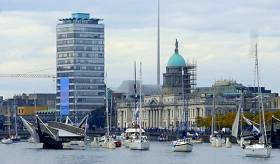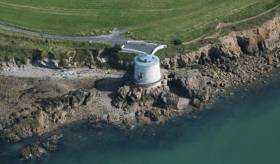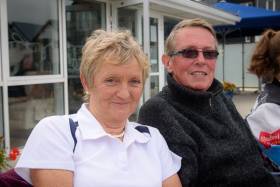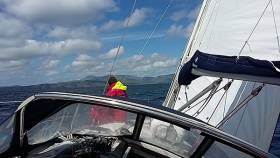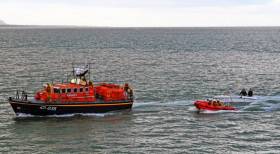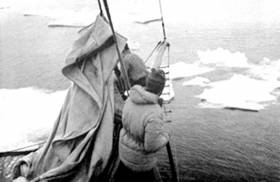Displaying items by tag: Cruising
Cruising Association Brings Sea Spirit Into The Heart of Dublin City
The Cruising Association of Ireland’s annual rally in Dublin’s River Liffey over the weekend brought a whiff of the open sea and a fleet of 32 boats into the heart of the busy city past the visiting “ten storey” cruise liner Nautica writes W M Nixon. And as one of the themes of the rally is the fleet’s negotiation of all the opening bridges upriver as far as the Customs House before returning eastward again in formation to berth at Dublin Port’s long pontoon immediately west of the Eastlink Bridge, inevitably there was interruption to shoreside traffic.


It’s astonishing how quickly the long vehicle queues can build up, and reactions to this brief stopping of the city’s bustling traffic were predictable. Tourists and locals just out for the day and ambling along the quays were delighted by it all. It isn’t until it happens that you realise just how rare are boat displays in the river with which people can identify, for they see themselves in the crews on the many boats which as ever – boats and people alike – were remarkable in their variety.

 “A bonny fleet comes into town” Photo: W M Nixon
“A bonny fleet comes into town” Photo: W M Nixon
But people on errands in cars or vans tended towards irritation until they saw the span on the Eastlink rising sky-wards, or the always fascinating Calatrava-designed Samuel Beckett bridge rotating to let the vessels through. Maybe it was wishful thinking on my part, but I though that the realisation of the co-ordinated project which was taking place had a soothing effect even on courier van drivers, while being a timely reminder that Dublin is Ireland’s largest port.
And as far as the welfare of our city port is concerned, even in the short year since the CAI was last in the river, the tower cranes have proliferated. Whatever about the future, there’s a building boom at present along the Liffey, and a sense of optimism.


Of course, for the main event on Saturday, the weather was benign. We’ll blot out Sunday’s rain, and instead simply recall that on Saturday CAI Commodore Clifford Brown presided over a full house of boats and people in sunshine, with the usual conviviality at the capacity crowd for the dinner on the restaurant ship Cill Airne.
This included a reception for the people working in Dublin Port and with the City Council who facilitated the co-ordinated opening of the bridges. So there was enthusiastic support when world circumnavigation veteran Pat Murphy of Aldebaran suggested that in future it simply be called The Three Bridges Rally. In fact, they should copyright the name immediately, for it’s a great way to bring the cruising season gently towards its close.
 Even with the full length of Dublin Port’s pontoon in use, fleet numbers were such that there still had to be some rafting up. Photo: W M Nixon
Even with the full length of Dublin Port’s pontoon in use, fleet numbers were such that there still had to be some rafting up. Photo: W M Nixon
Cruising Association Of Ireland Has 'Problem Of Success' With Up-Coming Liffey Rally In Dublin
One of last year’s most successful events was September’s Cruising Association of Ireland Rally in Dublin’s River Liffey writes W M Nixon. This involved the varied fleet – many of them much-travelled cruising boats – going in convoy through all the opening bridges as far as the Customs House in a fascinating Saturday afternoon logistics exercise co-ordinated by Dublin Port, Dublin City Council, and the CAI’s John Leahy.
Afterwards, with the fleet berthed at Dublin Port’s then-new pontoon immediately upriver of the Eastlink Bridge at what all true Dubs still think of as the Point Depot, the programme continued across the river with a welcome aboard the German sail training vessel Gorg Foch which was in port on an extended visit. Then the Captain of the Tall Ship with members of his crew joined with the CAI members for a reception aboard the river-berthed Restaurant Ship Cill Airne, followed by a full-house dinner using the Cill Airne’s renowned hospitality services.
The trouble is that when you make such a success of the first attempt at such a challenge, not only do people expect something similar or even better the following year, but as well the key mover and shaker finds that, if anything, he is responsible for even more of the hands-on organisation.
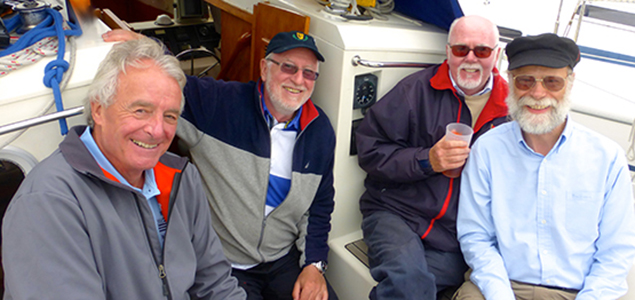 Cruising Association movers and shakers at last year’s Liffey Rally include (left to right) John Leahy, CAI Commodore Clifford Brown, Denis Woods, and Simon Parker. Photo: W M Nixon
Cruising Association movers and shakers at last year’s Liffey Rally include (left to right) John Leahy, CAI Commodore Clifford Brown, Denis Woods, and Simon Parker. Photo: W M Nixon
So as of this morning, John Leahy finds that he already has a full house for the CAI hog roast supper aboard the Cill Airne on the evening of Saturday September 17th to celebrate all that afternoon’s through-bridges manoeuvrings and evolutions. And on top of all that, he is CAI Honorary Secretary, he the Association’s Director of Waterborne Activities, and in recent months he has also found himself in the vital role of CAI Webmaster.
Obviously it’s not a situation which is going to last. But while it exists, you might as well take advantage of it in making instant administrative decisions simply by having an immediate consultation with yourself. So having found that, with just 27 boats booked in, all seating available for the hog roast supper on the ship was thus taken up, didn’t the bould John decide that the supper would start promptly at 7.30pm in order to end neatly within an hour or so, and thereby provide plenty of time for the second part of the evening, a night’s entertainment in the roomier part of the ship. At that convivial gathering, people who had failed to make the cut for the supper could then join the accelerating festivities.
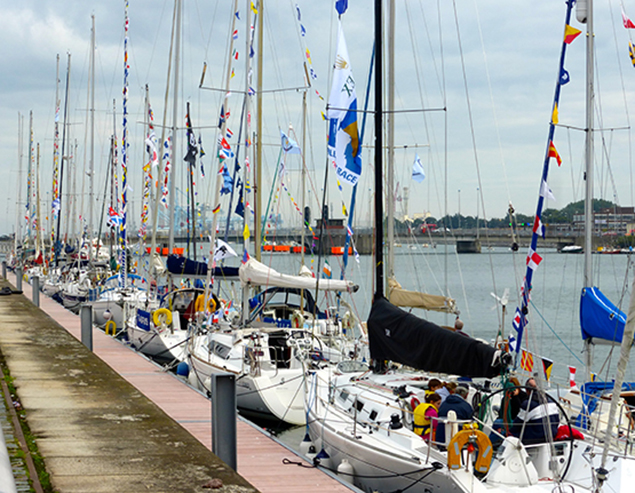 Dublin Port’s pontoon immediately upriver of the Eastlink Bridge can accommodate forty boats with permitted rafting layers. Photo: W M Nixon
Dublin Port’s pontoon immediately upriver of the Eastlink Bridge can accommodate forty boats with permitted rafting layers. Photo: W M Nixon
It’s a situation which arises because the Pontoon Berth above the East Link can actually accommodate 40 boats, and it’s highly likely that up to a dozen additional CAI craft will decide nearer the date that they want to be involved. So the idea is that after the river events and the pontoon-berthed socializing, the extra crews will either have supper on board their own boats or at one of the nearby shoreside hostelries, and then head to the Cill Airne for the main event.
That will include a reception for Dublin Port personnel and Seamus Storan of Dublin City Council, who between them give generously of their time and expertise to ensure that the co-ordination of the bridge openings all runs smoothly. When you think of how rarely you see some of the bridges other than the Eastlink being opened, it gives some idea of how much of a “Once a Year” exercise this has become.
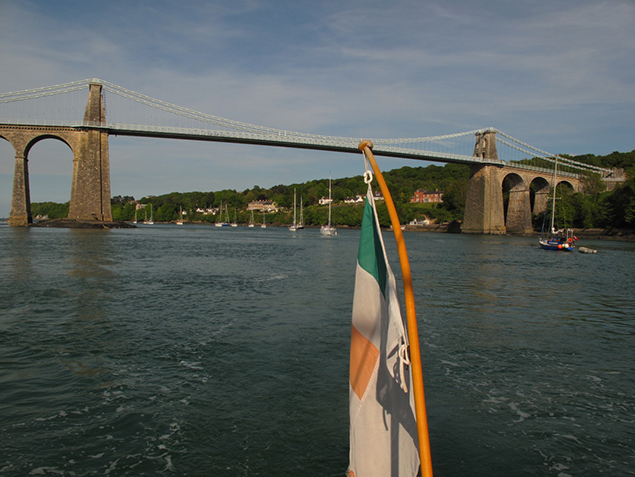 The CAI fleet in August passing under Thomas Telford’s famous 1826 suspension bridge in the Menai Straits in North Wales. Photo: CAI
The CAI fleet in August passing under Thomas Telford’s famous 1826 suspension bridge in the Menai Straits in North Wales. Photo: CAI
This is proving to be a “Year of the Bridges” for the CAI, as the last time they assembled in significant numbers was at the beginning of August. That was when they had their annual rally to North Wales, an entertaining week which includes transitting the Menai Straits where the two spectacular bridges are at such a height that even the tallest masts can pass comfortably underneath, leaving the boat crews free to enjoy a contemplation of the pioneering engineering involved in the bridges’ construction while also dealing with the renowned tides of the Swellies.
The tides of the Liffey are much more manageable, but nevertheless all signed-up or would-be participants in the CAI Liffey Rally on 17th-18th September 2016 are advised to keep closely in touch with the CAI website.
 The Menai Strait’s Britannia Bridge was also negotiated by the CAI fleet in August. Photo: CAI
The Menai Strait’s Britannia Bridge was also negotiated by the CAI fleet in August. Photo: CAI
An exemplary three year Atlantic circuit sailing cruise was completed this weekend with the return to Ireland of Neil Hegarty’s Dufour 34 Shelduck from Cork. Shelduck has reached Baltimore in the last of the summer after a rugged 16–day west-east Transatlantic return crossing from Newfoundland writes WM Nixon. The voyage saw the veteran skipper and his crew coping with at least one Force 8 gale and a definite Force 9, but in all conditions he was happy to report that his well-proven ship “behaved impeccably”.
Shelduck visited many coasts, harbours and islands during her time on the other side of the Atlantic, and was awarded the Irish Cruising Club’s premier trophy the Faulkner Cup, for 2014, while Neil Hegarty was also an Afloat.ie “Sailor of the Month” for February 2015. He is noted for the high quality of information provided with his logs, and for his careful planning to make time available for detailed local cruising by laying up the boat in North America for two winters. As well, as his cruising partner Anne Kenny of Tralee had the 36-footer Tam O’Shanter in the Baltic, parts of the cruising season in the Northern Hemisphere were given over to Scandinavian ventures.
However, for 2016 and the final summer in America, Neil and Anne joined Shelduck in Southwest Harbor, Maine on June 1st, and cruised extensively around North Maine, New Brunswick, Nova Scotia, Labrador, and Newfoundland. Then in Lewisporte in Newfoundland, they made the final preparations for the Transatlantic crossing to start in mid-August, and strengthened their crew with the addition of Neil’s son Paul – who’s an electronics and communications ace – and Charlie Kavanagh, whom the skipper describes as “a very good foredeck hand, Anne and I stuck to the cockpit…….”
During the summer of 2016, the North Atlantic was in a decidedly restless condition for much of the time, and though Paul Hegarty’s communications network during the crossing ensured that they minimised their contact with bad weather, there were some storms that just coudn’t be avoided. Yet this well-found boat and her experienced crew came through with flying colours.

#Rescue - Twelve kayakers rescued amid difficult weather conditions in Dublin Bay yesterday had only limited safety equipment and had not logged their trip with the coastguard, as The Irish Times reports.
The kayaking group were recovered by the Howth Coast Guard and lifeguards from nearby Dollymount after high winds and an outgoing tide started pushing them out into the bay off Red Rock in Sutton yesterday evening (Sunday 7 August).
It since emerged that the 12 paddlers had failed to observe the small craft warning issued ahead of yesterday's forecast high winds, on top of setting out without a marine VHF radio and failing to log their journey with the National Maritime Operations Centre.
Elsewhere, four people were rescued after a fire broke out on their cruiser on the River Shannon near Banagher in Co Offaly at the weekend.
According to The Irish Times, the four on board the White Lady raised the alarm on Saturday evening (6 August) after the fire started in the boat's engine system.
The skipper was able to motor the boat to Banagher Harbour where waiting fire service units brought the blaze under control.
Kinsale Sailing Couple Complete Round the World Voyage
Round the World Irish sailing couple Paraic O'Maolriada and Myra Reid returned to their home port of Kinsale in County Cork at the weekend having completed a six–year circumnavigation writes Bob Bateman.
The fluent Irish speakers returned to the West Cork port on Saturday in their 63–foot long yacht 'Saol Eile' to be greeted by family and friends. The craft was dressed with flags from all the countries they had visited over the course of their 43,000 nautical miles voyage.
Paraic, a non–swimmer, was formerly a master brewer in Guinness Brewery who has also designed breweries in Scotland. Paraic says it was a relatively quick decision to 'pack it all in' and take on the global journey.
 Above and below: The 63–footer yacht Saol eile safely back in Kinsale after its round–the–world voyage. Photos: Bob Bateman
Above and below: The 63–footer yacht Saol eile safely back in Kinsale after its round–the–world voyage. Photos: Bob Bateman
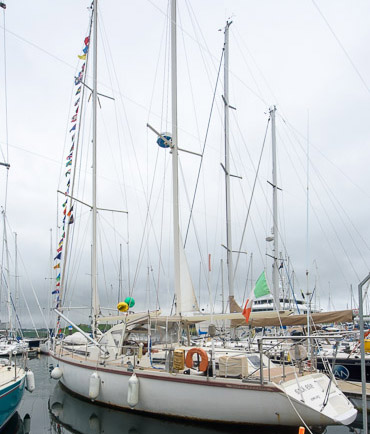
The couple prepared for the journey in 2010 with assistance from Zafer Guray of Bantry who gave them tips about how to handle the boat with just the two of them onboard.
Married for 49–years, Paraic and Myra said their scariest moment of all came on day two when the short–handed couple encountered a force nine storm in the Bay of Biscay.
Their most pleasant cruising experience was in Namibia, sighting hundreds of thousands of birds pelicans and flamingos. Another place they loved was Madagascar with its multitude of beautiful anchorages. But Myra says overall that 'the best part of the trip was being home'.
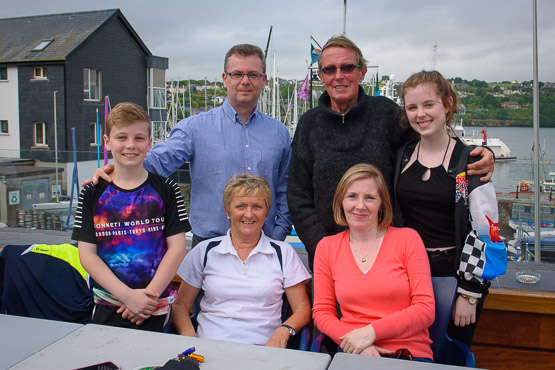 Round the World Irish sailing couple Paraic O'Maolriada and Myra Reid reunited with family at Kinsale Yacht Club. Photo: Bob Bateman
Round the World Irish sailing couple Paraic O'Maolriada and Myra Reid reunited with family at Kinsale Yacht Club. Photo: Bob Bateman
#RNLI - Lough Derg RNLI's lifeboat launched this morning (Friday 1 July) to assist four people on board a 40ft cruiser whose anchor came loose and dragged beneath their boat in severe weather.
At 11.20am Valentia Coast Guard requested the lifeboat to attend to the cruiser located by Hare Island.
The lifeboat launched at 11.42am with helm Peter Clarke, Lorna Walsh and Barry Morkan on board. Winds were south-westerly Force 5, gusting 6/7, with good visibility.
The lifeboat was alongside the cruiser at 11.52am. Everyone on board was safe and unharmed and wearing their lifejackets.
An RNLI crew member reassured everyone on board the cruiser. Given the severe weather conditions and the exposed location, it was decided to let the anchor go when it could not be recovered back on board after numerous attempts.
The cruiser for any other potential problems, and everything was found to be in working order, so it continued its journey to the public harbour at Dromineer where it took shelter.
The lifeboat returned to station and was ready for service again at 1.14pm.
Lifeboat operations manager Liam Maloney advises boat users to "check the weather before setting out from harbour and ensure all items are stowed correctly".
Round Ireland Sailing But at a Leisurely Pace!
As Afloat.ie reported in April, Sailing In Dublin Club yacht Silverwind set out on the first of its fourteen week long cruises around Ireland this summer. Club member Damien Byrne describes his week long cruise with stunning views of West Cork.
After two weekend delivery trips, the first from Dun Laoghaire to Kilmore Quay and the second weekend onto Kinsale, Sailing In Dublin Club’s yacht Silverwind set out on the first of its fourteen week long cruises around Ireland. Each of the fourteen weeks, will see the Clubs cruising yacht manned by different members each week, move around the coast of Ireland. On Saturday the 11th June the first crew of five met onboard the Sun Odessey 35, skippered by club Captain Linda fFrench. Of the five crew Linda, Damien and Ann are based in Dublin with Peter based in Co Clare and Anthony in West Cork. The crew was a mix of seasoned and novice sailors.
Having provisioned on the first day the crew set off for Glandore. On route the Captain, went through the safety procedure and equipment on board and also practiced man overboard procedures. The relatively short trip allowed the crew to become familiar with the boat and allowed some time to find their sea legs. The first night involved anchoring in Glandore on a wet evening and the crew cooked on board.
The following morning was a nice bright morning and allowed Anthony to view his home town from a different angle than normal as the boat left for Baltimore. With the winds from the Northwest the crew faced a beat to Baltimore Harbour. On arrival in Baltimore Bay the crew tied up at the more sheltered Sherkin pontoon at the Islanders Rest Hotel. The Hotel provides great food especially the fish dishes which were enjoyed by all. The forecast for Monday included a small craft warning and the crew decided to stay tied up for the day. This time allowed a full walking tour of Sherkin Island which ended in time to watch the first of Ireland’s games in the Euro championship. As there was other boat crews also tied up there was a big crowd watching the match though many did not appear to be too familiar with the game of soccer!
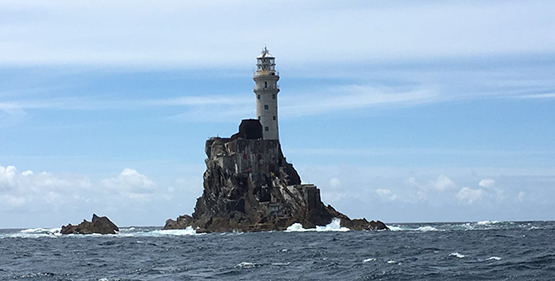
On Tuesday the crew intended to head for Lawrence Cove on Bere Island via the Fastnet, and after a healthy breakfast, and sandwiches made for the long day ahead, they headed out to sea. The sun shone, basking shark and dolphins were spotted, and the crew got great pictures of The Fastnet (above). However it was turning into a long day of sailing, and with a strong and unfavourable wind and lumpy seas, a mixture of sailing and motor sailing, the crew opted for plan B and headed into the sheltered harbour of Crookhaven and picked up a visitor mooring. It was a glorious sunny afternoon so a picnic of a selection West Cork cheeses was enjoyed on deck. Later the crew blew up the dinghy and headed ashore for dinner. After a drink in the local un-crowded hostelry they headed for the local restaurant which appeared almost empty only to be told they were fully booked out with a bus load of tourists which were about to arrive! The only option was to head back out to the boat for a West Cork culinary breakfast of Clonakinty puddings and sausages which we had intended for the morning.
Overnight the wind dropped and the morning was beautiful and sunny as the crew once again headed for Lawrence Cove marina in Bere Island (below). With a favourable wind they sailed past the Mizen and then as they turned north, resorted to the engine to get to Bere Island before the winds increased later in the day. Being under engine allowed the boat to hug the coast and get close up views and pictures of Mizen Head, Three Castle Head and Sheep Head. On arrival in Lawerence Cove we were met by the friendly marina owner Rachel who provided us with plenty of local information and booked a reservation for us in the Lookout restaurant. Although this restaurant is located at the other end of Bere Island the restaurant operates a free shuttle service to and from the restaurant. All the crew enjoyed a fabulous feed of scallops and fresh fish. The family that own the restaurant were also involved in the salvage of the tallship Astrid (which sank off the Cork coast in 2013) and pictures of the salvage operation are on view in the Restaurant. The crew also walked around the old Navy base which was occupied by the British until 1938. Some of the Navy buildings were used by Glenans sailing school until 1993.
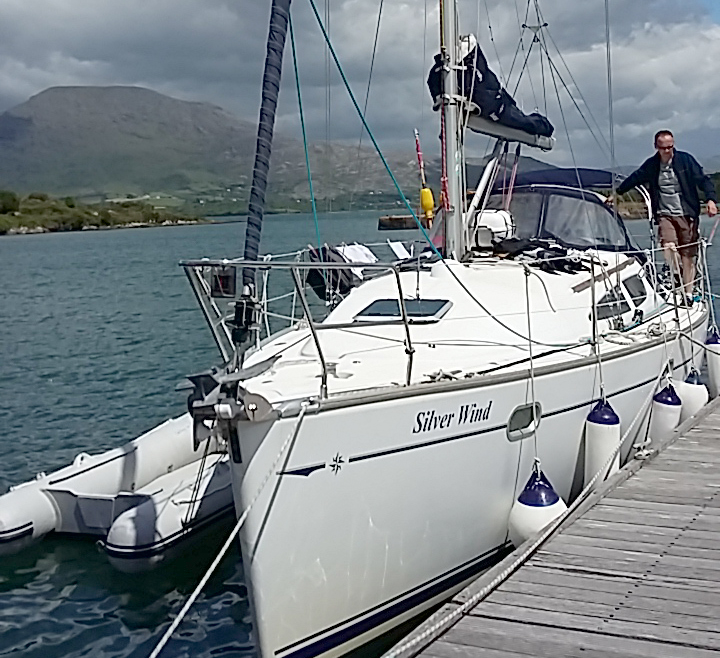
The crew set off the following day for Derrynane. The wind was again strong from a Northerly direction and the crew were very happy to tie up to a visitors mooring in the very sheltered and beautiful harbour. Friday was the last day of sailing and with beautiful sunshine and winds moderating, it turned out to be one of the most enjoyable days sailing. The crew got good views of the coast and of the Skelligs, pods of dolphins swam along with the boat a few times and Fungi the Dingle dolphin also made an appearance when entering Dingle Harbour. After a night out in Dingle with lots of traditional music and craic, all that was left to do was to clean the boat for the next Crew who will bring the boat further on its journey around Ireland.
All in all it was a fabulous week cruise with stunning views of the West Cork and Kerry coastline and Islands, with visits to the more remote parts of Ireland and close encounters with dolphins and basking sharks. Sailing In Dublin Club provides a fleet of boats and the company to sail and cruise in Ireland at very low costs. For more information visit www.sailingindublin.ie
Wicklow Lifeboats Assist Two On Motor Cruiser
#RNLI - Both Wicklow RNLI lifeboats launched after 7.20pm on Sunday evening (22 May) to assist two men in a small motor cruiser near Wicklow Head.
A member of the public contacted the Irish Coast Guard after seeing the men bailing water out of the vessel.
The motor cruiser was located about a half-mile northeast of Wicklow Head a short time later.
Weather conditions on scene were described as having a moderate sea state with north-easterly Force 3 winds and good visibility.
The boat was taken in tow by the all-weather lifeboat back to Wicklow Harbour, where the two occupants were taken ashore safe and well by the inshore lifeboat crew.
H.W. ‘Bill’ Tilman’s mountain travel philosophy, rooted in Africa and the Himalaya and further developed in his early sailing adventures in the southern hemisphere, was honed to perfection with his discovery of Greenland as the perfect sailing destination. His Arctic voyages in the pilot cutter Mischief proved no less challenging than his earlier southern voyages. The shorter elapsed time made it rather easier to find a crew but the absence of warm tropical passages meant that similar levels of hardship were simply compressed into a shorter timescale.
First published fifty years before political correctness became an accepted rule, Mischief in Greenland is a treasure trove of Tilman’s observational wit. In this account of his first two West Greenland voyages, he pulls no punches with regard to the occasional failings, leaving the reader to seek out and discover the numerous achievements of these voyages.
This extract is taken from Chapter X11: To Godthaab and Evighedsfjord, which sees Mischief sailing through pack-ice en route to Cape Farewell.
Cape Farewell, so named by John Davis, is the southern extremity of an island 2700 feet high. Surrounded as it is by high mountains it does not stand out prominently, but like most capes that mark the culminating point of large masses of land it is noted for stormy weather. In addition much ice accumulates round it, sometimes extending as far as 150 miles seaward. But the average distance is seventy miles in April, decreasing in August to thirty miles. For our part we could not have rounded it in fairer conditions. Sailing west-northwest parallel to the coast, mountains glistening all along our starboard hand, we romped along at five knots over a sparkling blue sea on a day of brilliant sunshine. And what fascination there is in the sight of this Greenland coast; how bracing the austere beauty of sea, snow mountains, and ice! In the morning we sighted only one big solitary berg and in the afternoon passed another close enough for us to take photographs. In order to have the best light we passed it on the wrong side, that is to leeward, where we had to dodge a number of bergy bits or growlers which had broken off. A German stern-trawler from Kiel altered course to have a closer look at us and greeted us with three blasts of his siren. The air temperature that day was 36° F. and the sea 42° F.

Kangamiut (left) and Evinghedsfjord
Next day we lay becalmed. It was an equally brilliant day and the few icebergs scattered about were curiously distorted by mirage. On this account, too, we could not make out whether a white bank all along the horizon to starboard was fog or ice. At the same time we were much puzzled by a low, rumbling noise. Some thought there must be a fishing boat about, others an aeroplane. True we had a bottle-nosed whale close aboard at the time but we could not hold him responsible for a noise like that. When a breeze sprang up we closed with this white bank and found it to be heavily congested pack-ice so distorted by mirage as to appear twice its height. It was this pack-ice that in spite of the perfectly smooth sea maintained the low menacing growl which we had heard from miles away. In similar circumstances John Davis and his company had been confounded by the noise of the pack: ‘Here we heard a mighty great roaring of the sea, as if it had been the breach of some shoare, the ayr being so foggie that we could not see one ship from the other. Then coming near to the breach, we met many islands of yce floating, and did perceive that all the roaring that we heard was caused only by the rowling of this yce together.’ We sailed to within a hundred yards of the pack to take photographs before standing out to sea. From so low a viewpoint as our deck photographs of pack-ice proved singularly unimpressive. In the vicinity of the pack the sea temperature was down to 34° F.
All next day as we drifted and sailed up the coast we had the pack in sight, for apparently it filled the whole of the Julianehaab Bight as far north as Cape Desolation. Ghosting along all night we tacked once to avoid a raft of small floes covering a mile of sea. The morning broke clear and sunny and again we found ourselves surrounded by floes with just enough steerage way to avoid them. A seal lay basking on a floe but when we tried to edge close the whisper of wind failed altogether and when we started the engine he dived into the sea. In the afternoon we ran into fog. The air temperature fell to 36° F. and the moisture on the ropes froze. By evening, the fog still persisting, we found our way barred by a narrow belt of pack-ice. Although the water beyond appeared to be clear of ice we hesitated to break through and coasted westwards alongside the ice searching for an opening. For four hours we motored at four knots, dodging loose floes, and still having the more solid ice about fifty yards away on our starboard hand. At length at ten o’clock, tired of dodging stray floes and thinking I saw an opening, I turned her head towards the ice. We were nearly through when in making a tight turn to avoid a floe on the port side we suffered a frightening blow below the water-line from a tongue of ice projecting from a floe on the starboard side. Those who were below were more than a little startled. As one man they rushed on deck to see what had hit us such a sickening thud. Assuming a calm which I was far from feeling I told them we had just grazed a bit of ice, that the ship appeared not to be sinking, and that at least we were through the ice and able to resume our proper course.
The book can be purchased directly from Afloat's Marine Market at €15.67 here
Coastguard Rescue For Cruiser Couple On Lough Derg
#Coastguard - Two people on board a 30ft cruiser were rescued by the Irish Coast Guard's Killaloe unit yesterday evening (Monday 23 May), as the Irish Examiner reports.
The coastguard team towed the boat into deeper water after it ran aground on Lough Derg before 6pm - and an ROV was used to confirm there was no damage to the underside of the vessel.



























